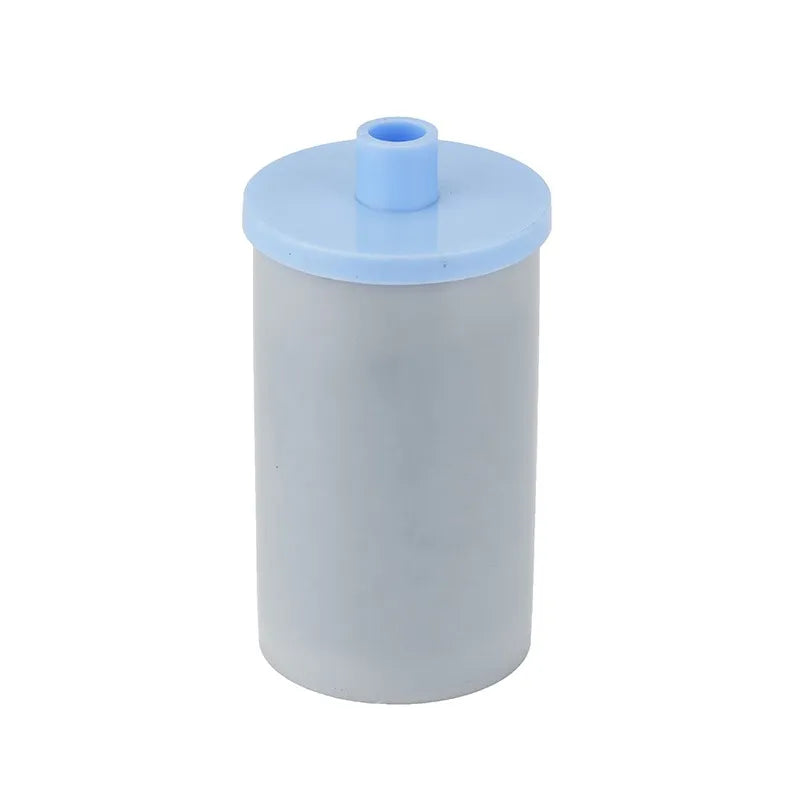Pet medical equipment
Disposable Gas Filter Canister Effective Absorption 200g
Disposable Gas Filter Canister Effective Absorption 200g
Không thể tải khả năng nhận hàng tại cửa hàng
Self Weight: 800 g
Effective absorption: 200g
Waste Anesthetic Gases
Inhalation anesthesia is a safe and effective method for veterinary anesthesia with great clinical benefits. That’s why both doctors and vets prefer to choose inhalation anesthesia in clinical treatments. If equipment is not setup or functioning properly or the waste anesthetic gases is not properly exhausted,these gases are unintentionally released into the hospital environment causing exposure risks for medical staff.
Sources of Waste Anesthetic Gases
1. Mismatched facemask
2. Spills of liquid anesthetics
3. APL valve blockage
4. Leaks caused by inappropriate endotracheal tubes
5. Leaks within the anesthesia machine, breathing system, hoses, and connections
6. Oversaturation of waste gas canister
Harm to medical staff:
The hazards of waste anesthetic gases are related to drug selection, pollution concentration and exposure time. Some potential effects of short term exposure to waste anesthetic gases are nausea, dizziness, head- aches, fatigue, and irritability. Long term effects include sterility, miscarriages, birth defects, cancer, liver/ kidney disease, and asphyxia. In addition, animal experiments indicate that anesthetics can cause memory impairment, which is generally believed to be temporary. Normal function recovers within a few days and cognition changes may last for weeks or longer.
In recent years, many projects have been devoted to the study of the correlation between anesthetics and Alzheimer’s disease. Researchers found in a vitro experiment that inhaled anesthetics enhance amyloid-beta oligomerization and cytotoxicity, which occurs in the neurons of Alzheimer’s.
Besides, it is observed that anesthetics are associated with the increased levels of proinflammatory cytokines, which leads to neuroinflammation and promotes the occurrence of Alzheimer’s disease.
Further researches should be carried out to confirm the clinical relevance of the results of in vitro studies and neurodegenerative complications under anesthesia and / or surgery in order to verify the relationship between anesthesia exhaust gas and Alzheimer’s disease. For medical staff who stay in the operating room all day, they should be self-aware and reduce exposure to anesthetics.
Tips: Currently, the US Occupational Safety and Health Administration (OSHA) suggests that staff should not be exposed to halide narcotic exhaust gas exceed 1h and the concentration should not exceed 2ppm while not exceed 0.5ppm when used in conjunction with nitrous oxide.
Harm to the environment:
The ideal anesthetic should be safe, effective and environmentally friendly. But in fact, the inhaled anesthetics commonly used in our clinic are all confirmed as greenhouse gases. The warming potential of isoflurane is approximately 1,230 times that of CO2. Isoflurane / sevoflurane discharged directly into the environment will pollute the environment and destroy the ozone layer.
How to avoid the exposure of waste anesthetic gas?
1. Use waste gas scavenging devices
2. Turn off the anesthesia system timely (vaporizer, oxygen flow meter, oxygen cylinder)
3. Choose a suitable facemask or endotracheal tube
4. Try to use a vaporizer adapter instead of open way
5. Enhance ventilation
6. Regularly check the anesthesia machine for leak
7. Strict anesthesia procedures and flexible anesthesia plan (local anesthesia combined with general anesthesia) can effectively reduce the use of inhaled anesthetics
Waste anesthetic gases emission methods
Due to the strict conditions of the operating room in human medical hospital, anesthetic exhausted gas in the room does not exceed the specified concentration through ventilation, which is difficult to achieve for animal hospital. At present, most animal hospitals often use two types of anesthesia exhaust gas discharges: direct emission(punching a hole in the wall and introducing the gas discharged from the anesthesia machine through the pipeline to the environment)—Not recommended; waste gas filter canister— Highly recommended.
The use of waste gas filter canister with anesthesia delivery systems is a very effective way to decrease waste anesthetic gases.
Advantages:
Complete absorption
Movable
Environmental protection, not polluting the atmosphere
Not affecting the pressure relief of the anesthesia system
Tips: Pay attention to the replacement conditions recommended by the manufacturer and replace them in time to avoid overloading the filter canister.
It is not recommended to decrease waste anesthetic gas in the operating room by direct emission. Although it can reduce the direct discharge of anesthesia gas to the operating room to a certain extent.
You should know that:
1. Because the density of isoflurane / sevoflurane is much higher than air, exhausted gas cannot be completely discharged and still exists in the system, which leads to the leakage in the operating room.
2. The waste gas pipeline is connected to the APL valve and the external environment, which may lead to humid air and dust recharge. And the recharged dust or vapor increase the risk of APL valve blockage. Therefore, during the operation, the veterinarian may encounter unexplained pressure relief disorder, which is manifested by high airway pressure and excessive inflation of the breathing bag, thereby increasing the risk of anesthesia. Once the vet does not notice in time, long-time over-expanded lungs may eventually rupture.
3. Moreover, once the APL valve is damaged, high cost and long term makes maintenance troublesome.
4. Pollute the atmosphere
5. It’s inconvenient to move the anesthesia machine
6. Occupational anesthetic gas exposure can lead to many health problems. Medical staff should have a sense of self-protection and reduce exposure to anesthetics.
Share


